Verizon iPhone 4: Thoroughly Reviewed
by Brian Klug on February 13, 2011 9:32 AM ESTCDMA vs GSM/UMTS iPhone 4 Nuances
There are a bunch of other subtle differences between the two iPhone 4 models, but they're relatively small things.
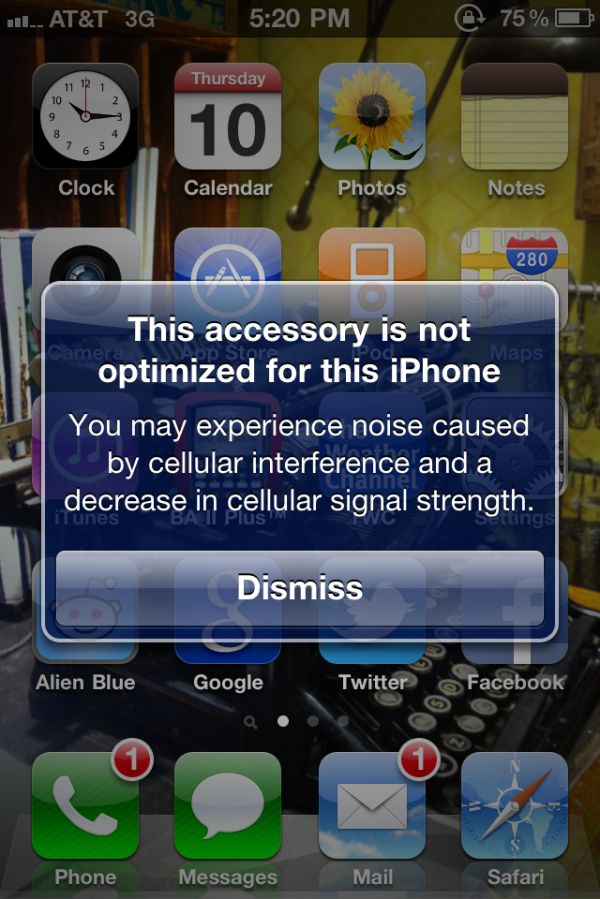
Accessory connection warning change - Left: AT&T iPhone 4, Right: Verizon iPhone 4
First off, the "audio interference" warning that's stuck around since the first iPhone is gone, like it should be.
Remember that 2G GSM/EDGE is TDMA - Time Division Multiple Access. In that multiplexing scheme, each phone gets assigned timeslots to transmit and receive during. When the phone is transmitting, because of the very short nature of those timeslots, instantaneous power looks like a delta function - it's a huge instantaneous pulse, even though time-average power is comparatively low. Well, the spacing of those pulses inside a multiframe is 4.62 ms, which corresponds to a very audible 217 Hz. This induces audible interference in unshielded audio systems. The solution Apple came up with was to require new approved accessory devices to shield components appropriately, and use an IC that would tell the device it was shielded. Other older devices pop up an alert about audio interference. Although 3G UMTS uses WCDMA, (which is fundamentally the same multiplexing scheme as CDMA2000, just a wider channel) the alert pops up regardless of whether the AT&T iPhone is on 2G or 3G. The phone can transmit continuously (no short, bursty nature) across the entire channel, and interference doesn't occur.
If you connect up a GSM iPhone to something that isn't shielded, you used to get that above dialog regardless of whether you're on 2G or 3G. Apple removed the audio interference part of that message, instead only warning about some attenuation which might happen from using a dock or battery.
There aren't too many other notable things - it's the same app store and interface as the AT&T version. There's no Verizon branded anything outside the carrier string. Of course, the fact that it's the same market means you can grab some AT&T specific apps like mark the spot and file some disingenuous bad signal reports. Maybe a tiny bit of app-segregation (or an API for determining whether the iPhone is CDMA or GSM/UMTS) could in fact be useful.
I noticed that the Verizon iPhone 4 also seems to get warmer than I remember the AT&T iPhone getting. It's something that's pronounced while charging or using 3G data a lot - perhaps the MDM6600 simply gets warmer than Infineon's X-Gold 618.
Screen slightly warmer
Our Verizon iPhone 4 review unit also has a noticeably warmer screen than the other AT&T iPhone 4s I've seen. Side by side with one, the difference is clearly visible. Our photos don't really do it justice, but the GSM/UMTS iPhone 4 is much more bluish than the Verizon iPhone 4, which has a warmer red hue.
I whipped out the X-Rite i1D2 used for display calibration and measured the white point. Sure enough, the Verizon iPhone 4 has a much different white point temperature than the AT&T iPhone 4. Brightness and black are similar enough to not be a huge difference, but that white point is seriously noticeable. Whereas the old iPhone 4 was reasonably close to 6500K, the panel in our Verizon iPhone 4 review unit is at 7120K. It doesn't show up in these photos or the overview video, but the difference is there.
Brightness and contrast are changed, but only slightly.
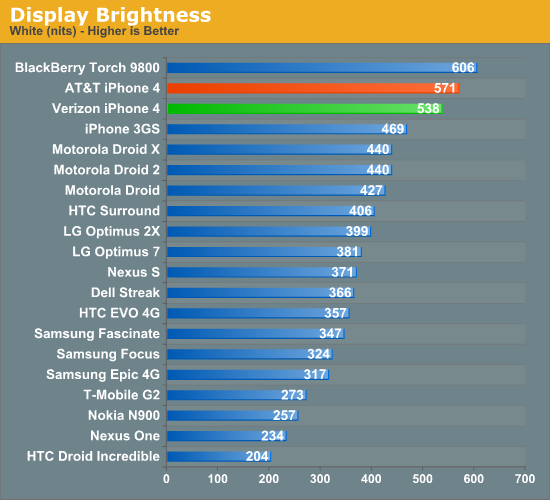
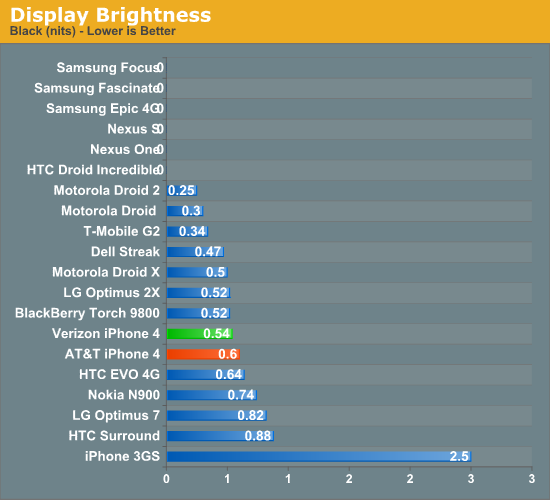
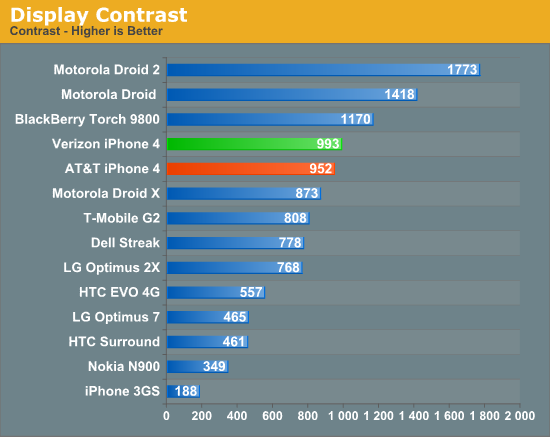
It's not clear whether Apple changed parts suppliers or this is simply a different batch of dissimilar panels. Either way, it's enough of a difference to be apparent almost immediately. The state of color accuracy on smartphones is awful to begin with, this is just another example of how huge the variance is even across a mature product line.
The Universal Bumper
To accommodate the moved insulate black strip, Apple also had to move the vibrate switch. It's slightly lower on the Verizon model, since leaving it in the exact same place as the AT&T version would've no doubt been too close to the end of the strip to be machinable.
The result is that new bumpers and cases are required. Apple sent a universal bumper, which has a longer vibrate port cut in the side to accommodate both versions of the iPhone 4. On both, you get a gap between the end of the vibrate switch and the port, but the result is that there's one bumper SKU.
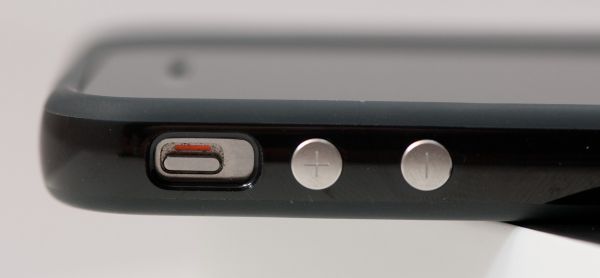
Top - Verizon iPhone 4, Bottom - AT&T iPhone 4 (in universal bumper)
Other legacy iPhone 4 cases are perfectly fine. For example, I use an Otterbox commuter which always had an oversized vibrate port. Luckily, it's just large enough to accommodate the Verizon iPhone. The position and feel of the volume up/down buttons is unchanged.



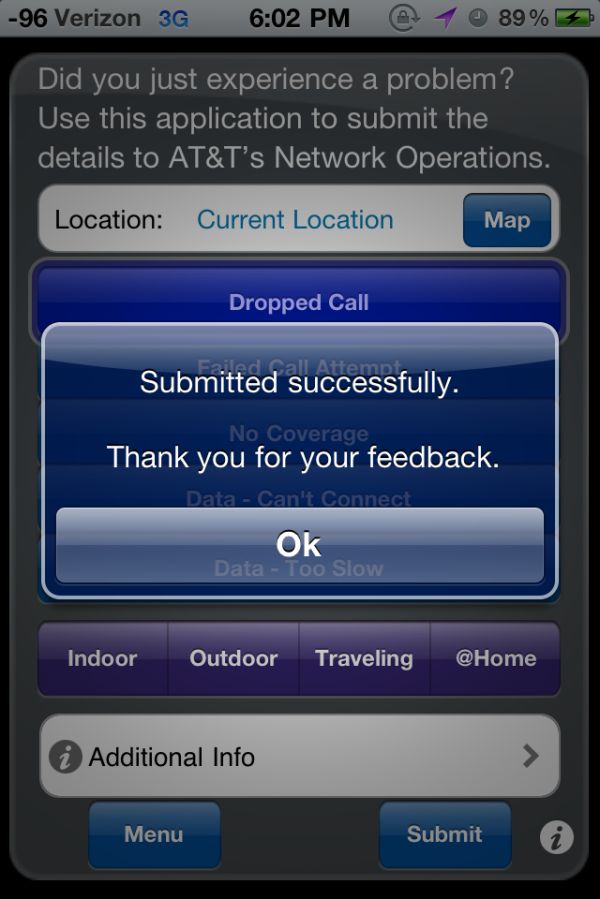
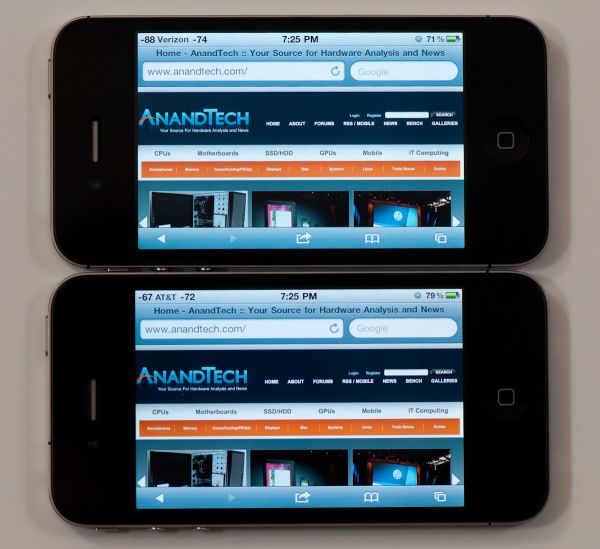
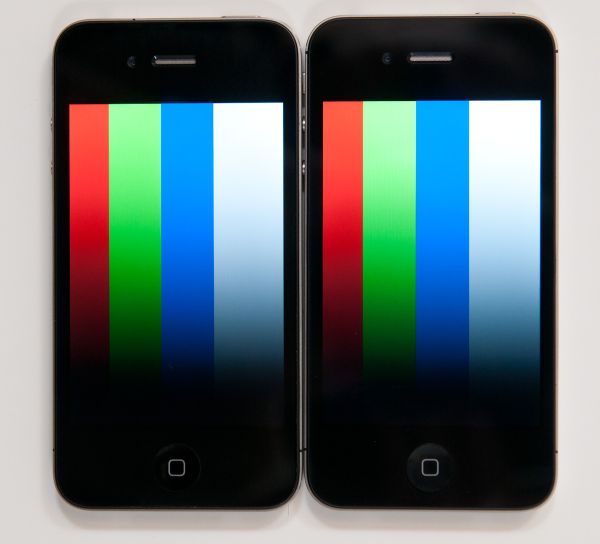
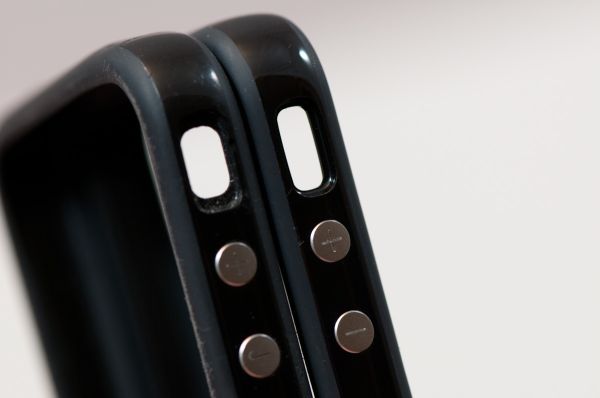









35 Comments
View All Comments
shakyone - Sunday, February 13, 2011 - link
Wife got the VZ iPhone 6 days ago. I use an Android phone. After one week, I have yet to experience one dropped call of 23, since it arrived, (used Android's call Log). It is as reliable as her VZ Blackberry. The audio is as good too. My brother has an AT&T iPhone 3GS. I don't talk to him that often, but it has dropped calls on me 3 of the last 7 times I called him in the last four months. I don't have much experience with friends that have the AT&T iPhone 4G.MonkeyPaw - Sunday, February 13, 2011 - link
ATT iPhone 3G user here. I have dropped calls all the time. Doesn't matter where I am. Our other phone is a cheap T-mobile phone, and even with a cheap 2 year old flip phone, calls rarely failed. The worst that happened was poor call quality on occasion.Wiggy McShades - Sunday, February 13, 2011 - link
Where do you live? I'm in the Boston area and have never once had a dropped call using an iphone 3g and now an iphone 4. I'm pretty certain my location is why I've had such a great experience with at&t, are you not near a major city? Or is it really just luck that the area I'm in is well covered?JimmiG - Sunday, February 13, 2011 - link
That really is abysmally slow.. not fast enough to watch video at decent quality, for example. I get around 3500kbps down/1400 up in my apartment on the outskirts of town using the HTC Desire and HSDPA, faster near urban centers.I wouldn't call it a smartphone unless you get at least 2Mb, maybe 1.5Mb/s out of it, since slower speeds render many of the features unusable, limiting you to texting and maybe browsing with images turned off.
dagamer34 - Sunday, February 13, 2011 - link
Some signal is better than no signal at all.Shadowself - Sunday, February 13, 2011 - link
This is *absolutely* true. Some signal is better than none.However, as the article mentions, this is very dependent on the individual. One person may almost never experience dropped calls on AT&T due to where and when they use their phone. In such a situation that person may adamantly prefer the AT&T iPhone over the Verison model. Alternately, another person may use their phone -- even in the same city -- in locals and at times where the phone routinely drops calls due to AT&T's network issues. In this case that user would just as adamantly prefer Verison over AT&T.
My wife's personal experience is that the parking lot of her office is a true Verizon dead zone. There is virtually no detectable signal there at all even with very sophisticated equipment and large antennas. You have to move several hundred yards from her parking lot (in almost any direction) for any Verizon phone to work. Verizon has known about this dead spot for over 8 years and has yet to negotiate a new tower in the area (or modify existing towers) to fill that hole. Therefore, for her Verizon is not an option.
It all comes down to what you need and *your" use.
vol7ron - Sunday, February 13, 2011 - link
Oh no. These Verizon vs AT&T flame-wars are almost worse than the Microsoft vs Apple.At least in the later, you had a constant product difference. In service providers its subject to location. And in major cities, I've never had a problem with AT&T except in metros, where they didn't have antennas and Vzn decided to put some up and large venues where you got a lot of units in one tight area at the same time, like large conferences or concerts.
I've had just as much trouble with Verizon black spots as I've had with AT&T. It's all based on where you are and where you travel.
asandok - Sunday, February 13, 2011 - link
In ifixit's teardown they say the wi-fi antenna is what you point out to be the cell antenna. Which is it? It looks like they made a boo boo. Awesome write up though! Love these!Brian Klug - Monday, February 14, 2011 - link
Indeed, the component they pointed to and called the WiFi antenna is the first of two cellular feed lines, and that part has indeed not changed. It's for cellular (and was on the GSM/UMTS iPhone) and not WiFi. Even the FCC correctly labels it as being a feed line for cellular. WiFi has always been at the top in the same place with the same package, though the WiFi antenna did change slightly with the Verizon version.-Brian
Montrey - Sunday, February 13, 2011 - link
Funny you mention how inaudible the vibrate is. I had my Verizon iPhone on vibrate during a physics test Friday, it rang in the pocket of my jeans and my professor heard it 20 feet away and threatened to kick me out if I didn't turn off my phone. Maybe he just has superhuman hearing, I thought it was pretty quiet, especially compared to the droid eris it just replaced.